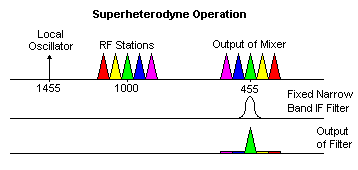Talk:Superheterodyne Receiver
SDR
A Software-Defined Radio (SDR) system is a radio communication system, a combination of hardware and software technologies, that allows reconfiguration of wireless network architectures. The Joint Tactical Radio System (JTRS) program sponsored by the U.S. Department of Defense to develop the next generation of military communication devices envisions the use of SDR technology with standardized hardware capable of handling multiple protocols used by the military today. SDR is a design philosophy that has been in existence for a long time and is going through a rebirth as a result of advanced semiconductor components now available, including high-performance digital signal processors and gate arrays, and high-speed data converters as well as advanced radio technologies. Although advances in DSP technologies have accelerated SDRs development, the main component that enables SDR is in the analog domain of high-speed data converter technologies. A software-defined radio receiver uses an analog-to-digital converter (ADC) to digitize the analog signal in the receiver as close to the antenna as practical, generally at an intermediate frequency (IF). Once digitized, the signals are filtered, demodulated, and separated into individual channels. Similarly, a software-defined radio transmitter performs coding, modulation, etc. in the digital domain In the final output IF stage, a digital-to-analog converter (DAC) is used to convert the signal back to an analog format for transmission
local oscillator frequency constant
LO - local oscillator frequency constant - where you tuned your radio.
Superheterodyne keeps LO - local oscillator frequency constant where you tuned it and complete FM signal is “mapped” to another IF - “intermediate” frequency (455 kHz for AM or 10.6 MHz for FM radio). The “mapping” is wide enough to fit complete FM signal bandwidth, it depends on the IF filter, e.g. 200 kHz for FM radio (or 20kHz for AM radio), so it does not need to track, e.g. 10 Hz narrow band changing frequency of modulated signal, it takes everything at once.
